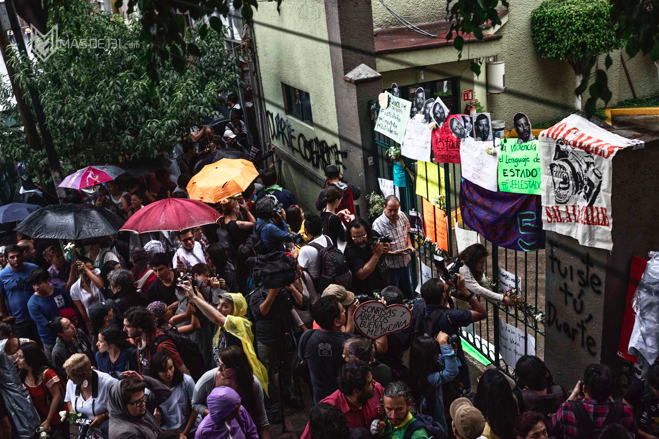
Image of Mexican photojournalist Rubén Espinosa, who was found dead and showing signs of torture. Retrieved from Espinosa's Twitter account @espinosafoto.
Mexico's leading free speech organization Artículo 19, announced that photojournalist Rubén Espinosa was found dead on Friday, July 31. Espinosa worked as a correspondent in the Mexican state of Veracruz for the magazine Proceso, Agencia Cuartoscuro, and AVC Noticias.
Along with Espinosa, four women were also killed in a Mexico City apartment in the middle-class neighborhood of Narvarte, one of them Nadia Vera, an activist from Veracruz.
#Mexico: Photojournalist Ruben Espinosa murdered – #JusticiaParaRuben http://t.co/u5lalBtLxT
— ARTICLE 19 (@article19org) August 3, 2015
#ALERTA: El caso de Rubén Espinosa es el primero en el que un periodista desplazado internamente es asesinado. http://t.co/52cOWchZMo
— ARTICLE 19 MX-CA (@article19mex) August 2, 2015
Attention: The Rubén Espinosa case is the first in that an internally displaced journalist is murdered.
After having received threats, the photographer fled from Veracruz to Mexico City in June of this year with the purpose of protecting his integrity.
Espinosa's death makes him the fourteenth journalist after Regina Martínez, Goyo Jiménez, Moisés Sánchez, Víctor Manuel Báez, Irasema Becerra, Guillermo Luna, Gabriel Huge, Esteban Rodríguez, Noel López Olguin, Miguel Ángel López, Misael López, Yolanda Ordaz, and Armando Saldaña to have been murdered during the administration of Veracruz's governor, Javier Duarte de Ochoa, who took office in December 2010. So far there has only been one arrest, for the murder of Regina Martínez.
“I left after having received several threats […] Veracruz is a lawless state,” Espinosa said in his last interview on July 9 with Rompeviento TV.
According to Artículo 19, the day before his attack, he headed the formal replacement of an honorary plaque for Regina Martínez, a journalist who was slain on April 28, 2012 in Xalapa, the capital city of Veracruz. As of this moment, three journalists have fallen in Xalapa, all of which have occurred during the Duarte administration.
Shot in the head
On August 1, the Mexican newspaper, El Universal, reported that five bodies were found in the Mexico City neighborhood of Narvarte in a building on Zempoala Street; one of them was that of Espinosa.
Family members, who had already reported him missing, identified the journalist's body, which displayed hits to the face and bullet wounds. All the victims received a shot in the head.
According to Proceso, in September 2013, state police had beaten Espinosa in Xalapa while he was documenting the violent removal of CNTE members from Plaza Lerdo. In addition, police forced him to erase from his camera's memory card all of the photographic material that had been taken that day.
Displaced journalist
Now in Mexico City, Rubén Espinosa was invited to participate in the Periodistas de a Pie program, which was transmitted on the internet television station, Rompeviento TV.
On the program, he denounced the constant threats against him and that of other journalists in Veracruz; and for that reason, he decided to leave the city where he had lived for seven years.
The late journalist stated that:
“Las condiciones son malas para todos los periodistas en Veracruz” .
“The conditions are bad for all journalists in Veracruz.”
He also denounced the criminalization which he fell victim to for having participated in the remembrance of Regina Martínez: “We have a group of colleagues that have called us guerrillas for installing a [honorary] plaque for Regina Martínez.”
Governor Duarte
On the other hand, there is audio circulating the internet via SoundCloud, in which the voice of Javier Duarte can presumably be heard in a meeting in the city of Poza Rica, Veracruz. The governor “advises” journalists to stay away from organized crime rings, and indicates that if “something happens to you”, it is for having been engaged in close proximity to these criminal groups.
He also stated that:
Es atractivo, es seductor en muchas ocasiones tener la primicia, tener la nota que uno de estos grupos criminales nos dé para poder publicarla, y poder ganar la nota y para poder asegurar la noticia pero créanme quien se mete con estas gentes generalmente termina mal.
On many occasions it's appealing and seductive to get the first news, to get the story that one of those criminal groups gives us to publish, and to be able to get that story and secure the news. But believe me, it normally ends badly for those who get involved with these people.
In the audio, the governor speaks to the journalists with an alleged petition: “…for your families, but also for me and mine; if something happens to you, I'm the one that gets crucified […] behave appropriately; we all know who's walking on the wrong side of the tracks.”
In addition, Duarte mentions that he knows who has close ties with organized crime: “We all know who has ties with these groups in one way or another; let us play the dumb card […] I ask you, please, to behave appropriately.” He then ends his speech with a threat:
Vamos a sacudir el árbol y se van a caer muchas manzanas podridas, yo espero verdaderamente, se los digo de corazón que ningún colaborador, ningún trabajador de los medios de comunicación se vea afectado por esta situación, y solamente se van a ver afectados quiénes de alguna u otra manera tienen una vinculación con estos grupos criminales. No hay que confundir libertad de expresión con representar la expresión de los delincuentes a través de los medios (…), vamos a sacudir fuertemente el árbol.
We're going to shake the tree and many rotten apples are going to fall. I truly hope, I say this from the heart, that no collaborator nor media professional will be affected by this situation, and that the only ones that will be are those who have ties one way or another to these criminal groups. We should not confuse freedom of expression with representing the voice of criminals via the media […] we're going to fiercely shake the tree.
Also in statements, the governor removes himself from any responsibility: “As the saying goes: fair warning leaves no room for surprises. I told you both openly and beforehand […] therefore, I ask nothing more of you—it's the only thing I ask—other than to behave appropriately. Don't stray off the path; don't get wrapped up in this matter.”
Based on the governor's words, Espinosa claimed that it was indeed a threat meant for all journalists in Veracruz.
“It's getting closer each time”
The murder of the five individuals shook Mexico's capital journalists; hundreds gathered at the Ángel de la Independencia, one of the most recognizable landmarks in Mexico City. A long time has passed since witnessing such a heavily attended protest. Perhaps this time because it hits closer to home seeing as how it took place in the nation's capital city. “It's getting closer each time,” says a colleague from the newspaper Reforma.

Protest outside the Veracruz government headquarters in Mexico City for the death of five individuals, among them, Rubén Espinosa and Nadia Vera. Next to the gate on the right it reads: “It was you Duarte”, alluding to the Veracruz governor. Photo: Eduardo Velasco Vásquez from More that 131.
Civil society also joined in by demanding justice, which also included that for Nadia Vera, an activist dedicated to Veracruz culture. She formed part of the collective #Yosoy132Xalapa [I am 132 Xalapa]. She was described as being a courageous woman and a critic of Duarte's administration. She emphasized on the state's violence several times in various interviews, and that the population finds itself among the harassment from drug traffickers and the omissions and impunity of the government. She even ensured collusion between the two.
People also spoke up for Yesenia Quiroz, who was a domestic worker from Colombia; for the moment this is the only known information about her. Both Quiroz and Vera were tortured and murdered in an apartment in the neighborhood Narvarte. The Mexico City authorities said that they would exhaust all possible lines of investigation, always stressing upon the point that the apartment had been robbed.
Therefore, journalist Témoris Grego made the demand during the protest that the first line of investigation be Espinosa's journalistic work.
In the last 15 years, we found that the murder of only one Mexico City journalist had been reported; it appeared in the newspaper Excélsior on November 15, 2006 by reporter José Manuel Nava.
The protest turned into a march. A silent and rainy march all the way to the Veracruz representation headquarters in Mexico City. While there, the rain intensified, but not before having cried Durate a “murderer”.







4 comments